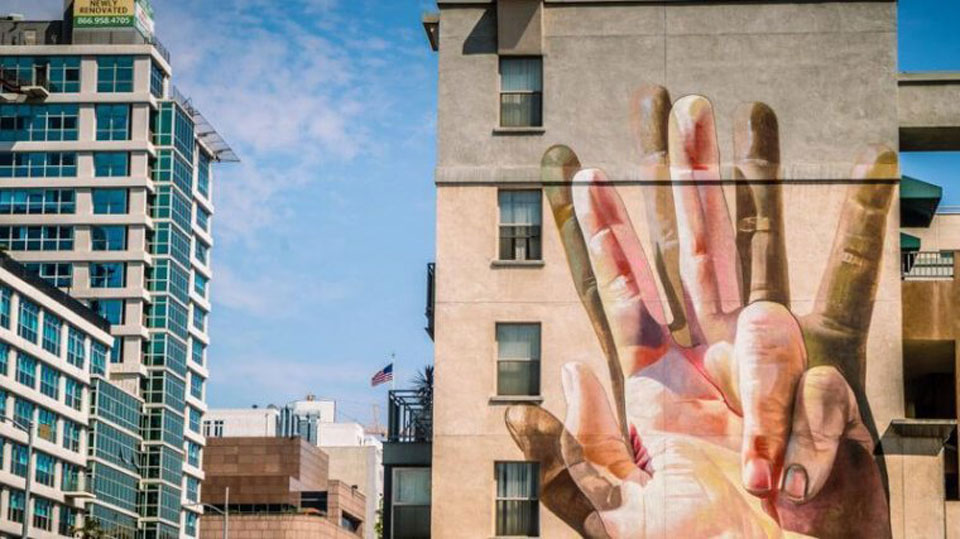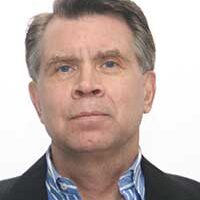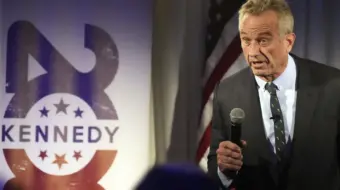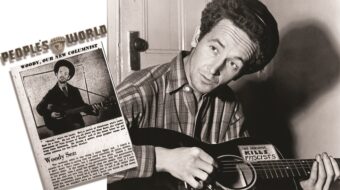
LOS ANGELES—Race is the way class is spoken in America, as Cornel West wisely pointed out, and that is especially true in the sprawling multi-cities that comprise Los Angeles. Money is the other way that class is constituted, regulated, and enforced. Both race and money are used to segregate this city of multiple contradictions and rigid, though often invisible, boundaries and barriers dividing one class from another.
Language, living quarters, and mode of transport are some of the ways class structure is imposed and this is visible in the architecture and layout of a city that was developed with no real center, but rather an endless sprawl that grew up wherever the next profitable real estate market appeared.
As Mike Davis points out in what is still the best book on L.A., City of Quartz, L.A. was the only major American city that lacked an industrial base—that is, a city mired in illusion and an illusory consumer and entertainment economy. Downtown L.A. did finally by the 1940s establish an industrial base including becoming a textile center, but then-Governor Ronald Reagan stripped that base and promoted its migration to Asia in the neoliberal era of the 1970s, before becoming president and applying this principle to the country as a whole.
Entire areas are continually remade as Downtown—whose motto is now “Live, eat, play in DTLA”—once the financial heart of the West, became a ghost town by the end of the 1950s. In the 1960s and 1970s, office buildings were deserted and left derelict as Anglos fled to the suburbs. A sweatshop culture that employed largely Hispanic and particularly Mexican workers established itself along the modest commercial streets, and the classic old movie theaters often becoming Latin concert gigs.
This section is now being reclaimed, gentrified, as the sons and daughters of those who fled move back to this left-for-dead area, now become an arts district, and begin ousting its Hispanic inhabitants as property values rise. This recolonization is marked by the transformation of what were once peasant markets into trendy, chichi eateries serving the latest craze “avocado toast” with names that transform ordinary breakfast into a rarefied and eroticized meal such as the currently wildly popular franchise “Egg Slut.”
There are whole sections of the city, particularly in the Mid-City and South Central areas where Spanish is the dominant language. Those areas are among the city’s poorest, with many of their homeowners struggling to survive by supplementing their day jobs by at night ferrying the city’s upper-middle-class elite, as Uber drivers. The poor ride buses, once referred to by the Anglo population as “shame trains,” but which today are being talked about as a source of public transportation which may allow the city to cut down on its pollution.
The boundaries between neighborhoods, enforced by real estate prices, are so rigid that a most common question is “Where do you live?” since the answer will determine one’s socio-economic status. If there is an incongruity in the answer, i.e., the person seems to be for example a bohemian living in a rich district, the second question to determine status is “What do you drive?”
This is also a city of class-based contradictions, with its class structure embedded in its cultural life and marked by division in its approach to monuments, museums, sports centers, and even its symphony orchestra.

This is starkly evident in two murals in the Olvera Street section of the city, itself a kind of tourist and cleansed celebration of the Mexican population complete with a clothing and trinket market and “authentic” restaurants. At the top and heart of the street is a mural depicting the “Mission” view of Hispanic culture with the Padre blessing the animals, a feast traditionally celebrated on the street, while the brightly garbed Mexican peasants, in a color depiction that resembles a Disney animation, kneel in humble adoration of the benevolent Spanish preacher.

This view of California as spiritually sustaining its Hispanic population is undercut, however, by a nearby mural titled America Tropical, painted in 1932 by the famous Mexican artist David Alfaro Siqueiros. The mural deploys a triptych construction within the same frame to show at the center—in traditional religious iconography the place for Mary, God the Father, or Jesus—a Mexican worker crucified, with the American eagle perched above him, haughty and oblivious to his suffering. To the right are two armed Mexican peasants readying themselves to fire on the conqueror. To the left is a mass of tangled industrial pipes that resemble tree trunks and that represent the transformation of a natural space into a for-profit, capitalized space.
After its well-publicized opening, this mural was quickly painted over—that is “whited out,” particularly the section with the armed Mexican peasants—and Siqueiros was deported. It is an accurate depiction of the Mexican struggle in the U.S., and was somewhat restored by the Getty Foundation, but can now only be seen from the roof of a museum dedicated to its origin with the colors now washed out, unlike the perpetually bright colors of the far more visible “Mission” mural, with its docile peasants.

A striking aspect of cultural life in L.A. is that of the four major museums: The Getty, Los Angeles County Museum of Art (LACMA), UCLA’s Hammer, and The Broad. Three are privately owned, with the Getty collection far outweighing the public LACMA offerings. Both feature a kind of Noah’s Ark approach to art history, that is, one of each kind of major painters and movements, but the Getty is a more supercharged turbo-Mercedes ark, featuring three to four of each kind compared to LACMA’s public, more impoverished Toyota, with barely one of each. Plans to construct a museum quarter around LACMA, including a facility dedicated to cinematic arts and another, the Petersen Automotive Museum, which already exists, have been criticized for a number of reasons, including the new architectural design for LACMA seemingly inspired by the dominant car culture.
Museum culture also raises the idea, central to the city, of illusion. The Getty Villa this summer is displaying articles from the city of Herculaneum on loan because the Villa is a reconstruction of the city near Pompeii which was leveled by the Vesuvius volcano in 79 CE. The striking aspect of this recreation is that the oil magnate J. Paul Getty, once the richest man in the world, had the money to rebuild the Roman city so that his vision of the locale is now more “lifelike” than what one sees in visiting the actual ruins outside of Naples.
Equally, Downtown L.A. is filled with abandoned, once palatial, movie theatres that are now only rented out for occasions such as Oscar parties, while one former restaurant functions only as a rentable site for which Hollywood period restaurant scenes are staged. This all pales into insignificance behind The Grove, in West L.A. near Beverly Hills, which is an artificial neighborhood that boasts high-end products, anchored by the Apple Store. Its false recreation of neighborhood complete with trolley recollects in tranquility quaint non-virtual ways of being such as pedestrian blocks, a former sign of working-class solidarity, and their artifacts: “newsstands,” “movie theatres” and, that most vanishing breed destroyed by Amazon, “book stores.”
Most touching in terms of monuments is a simple obelisk at the corner of Lincoln and Venice Blvds., marking the site where Japanese-Americans were herded into transports taking them to concentration camps at the onset of World War II. The purpose of the plaque is to preserve the memory of this painful incident so that it will not happen again, even as a former camp at Fort Sill, Okla., is now being used as a detention center, i.e., concentration camp—for immigrant infants separated from their parents. The contemporary television series The Terror, now in its second season, centers around the deportation.

More prominent than museum culture in L.A. is sports stadium culture, with the baseball team, the L.A. Dodgers, having one of their finest seasons. A number of games have virtual transmissions, like a YouTube broadcast of a mid-day game against the St. Louis Cardinals, which the Dodgers won thrillingly in the last out. Here too the spectacle, itself a palliative in a city awaiting, as is the rest of the U.S., a looming recession, is always mixed with commercial gain. When the organist played the traditional baseball theme “Take Me Out to the Ball Game,” the neon video streamers displayed all of the various Coke products so that Coke supplanted the song’s more ancient “Buy me some peanuts and Crackerjacks.”
Stadium building with its subsequent displacement of often poorer populations in the surrounding area is accelerating, especially in Inglewood, soon to be the site of the Rams football stadium for 70,000 fans, and the Clippers basketball arena. There is a section of Inglewood known as the “Black Beverly Hills,” home in former times to musical luminaries Ray Charles and Tina Turner, which now may be on the stadium chopping block, as L.A. also gears up for the 2028 Olympics.
The creation of Dodger Stadium was the initial massive land grab in the heart of the Chavez Ravine’s Latino community. In the 1950s this area north of Downtown was constantly expanding and needed additional public housing, which was proposed by the mayor but was red-baited at the time and declared an un-American socialist solution. This failure to develop the land allowed the Dodgers and the city to claim it. Inside the stadium are photos of the bulldozed, leveled land, portrayed as barren and remade as the site of a majestic ballpark. In the combination of Dodger Stadium and the remaking of Downtown L.A.’s Bunker Hill into a corporate site, now overlooking or “looking down” on the city, over 12,000 residents lost their homes.

To end, though, on a note of resilience, this summer also saw the continuation of the Youth Orchestra of Los Angeles (YOLA), headed by Los Angeles Philharmonic conductor Gustavo Dudamel, celebrating his tenth year as musical director. In line with U.S. tradition like Leonard Bernstein’s Young People’s Concerts, but inflected with Dudamel’s experience with his Simón Bolívar Symphony Orchestra of youth performers in Venezuela, YOLA reaches out to poor and minority communities to fashion a high-school orchestra of the highest calibre, which then holds a final concert, partly conducted by Dudamel.
To end, though, on a note of resilience, this summer also saw the continuation of the Youth Orchestra of Los Angeles (YOLA), headed by Los Angeles Philharmonic conductor Gustavo Dudamel, celebrating his tenth year as musical director. In line with U.S. tradition like Leonard Bernstein’s Young People’s Concerts, but inflected with Dudamel’s experience with his Simón Bolívar Symphony Orchestra of youth performers in Venezuela, YOLA reaches out to poor and minority communities to fashion a high-school orchestra of the highest calibre, which then holds a final concert, partly conducted by Dudamel.
The passionate conductor began the night with his simple, “I am from a country called Venezuela,” a statement which—with him surrounded by these diverse young musicians brimming with talent, zest and confidence—was a powerful and understated way of contradicting current U.S. propaganda waged in its quest to short-circuit oil competitor Venezuela and steal its assets.
The concert included an Asian and African-American conductor (Soo Han and Roderick Cox) preceding Dudamel, an orchestral number conducted by Dudamel which featured Venezuelan folk musicians backed by the orchestra, and a repertory boasting the contributions of early African-American symphonic pioneers William Grant Still and Florence Price. The concluding number, Brahms’s Hungarian Dance No. 5, illustrated the way the classical canon is partially made up of contributions from minority groups with the melodies in the piece largely drawn from Roma or Gypsy music.
It was here, in this touching melding of so many culturally disparate spirits, that a truer vision of an evolving Los Angeles, took shape and form. It is an alternative vision that counters the city’s history of land and cultural appropriation and suggests a more inclusive society and a breaking down of its still rigid class barriers.
Reposted with minor edits by permission of the author from Culture Matters.












Comments